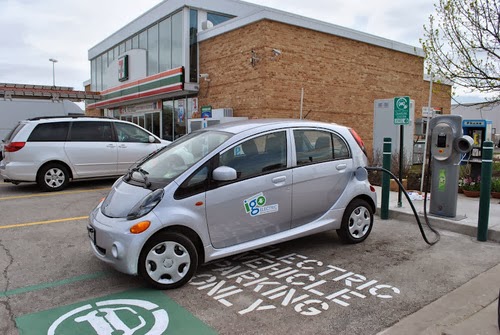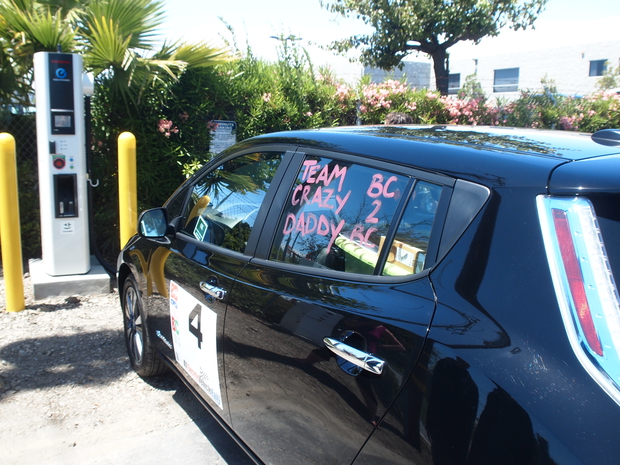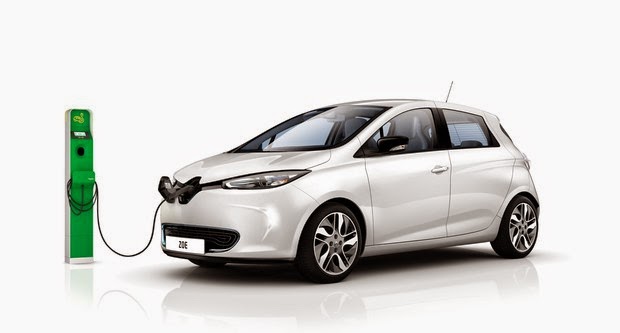Electric cars are more useful when they can be quickly charged. Case in point is the Tesla Model S, which can gain about 300 miles of range per hour of charging, making it the first electric car that’s suitable for proper American style Road Trips. The “range anxiety” bugaboo largely derives from the slow charging rate of modern electric cars. At 6.6 kilowatts you gain about 22-25 miles range per hour of charging, which isn’t very fast. Our gasoline powered brethren can recharge 300+ of range in about 5 minutes.
What’s holding us back from electric cars with fast charging?
The J1772 standard supports up to 19 kilowatts, which equates to 70 miles or more per hour of charging. That would be fast enough for all but the proper American Road Trip. As Tesla demonstrates, that would require a 100+ kilowatt charging rate.
There are two interlocking problems:
Charging network operators are building infrastructure for 32 amp charge rate
Electric car makers are building cars supporting 6.6 kilowatt charge rate (32 amps 240 volts)
Assuming it’s technically feasible for the car makers to build higher powered on-board chargers (the Renault ZOE supports 43 kilowatt AC, and the European Smart ED supports 22 kilowatt AC), do the car makers have the incentive to do so if the charging station infrastructure is a paltry 32 amp? No.
The charging network operators likewise have little incentive to install higher powered stations if the car makers aren’t building cars that require higher powered charging. Higher powered charging infrastructure is a bigger investment – for higher capacity electrical service, higher capacity wiring, and higher capacity charging equipment – to support 70 amp charge rates. What’s the better payoff on their investment? To install a single 70 amp charging station or two 32 amp charging stations?
That is – for a given electrical service level – say, a 100 kilowatt line to support a bank of charging stations. On a 100 kilowatt budget the network operator could install five 20 kilowatt AC charging stations, or about sixteen 6kw charging stations. Which is preferable?
Actually, what would be preferable is a system to share power among the available charging stations on a site. The network operator could run that 100 kilowatt line, install twenty stations each capable of 20 kilowatt AC, and configure the stations so they talk with each other and adjust the charging rate so total demand doesn’t exceed 100 kilowatts. Auto-adjusting the charging rate based on demand would be a useful compromise, reducing the charging rate at peak demand times but giving the network operator some needed control.
The ChargePoint CT4000 stations do this on a small scale. It’s one station, with two plugs, and can be configured to support one 32 amp circuit that can be shared between two cars.
The idea relies on the communications between charging station and car where the car and charging station agree on the charging rate. If the station needs to reduce the rate, it can tell the car to do so, and the car is supposed to respond by lowering its demand for power.

We, the electric car drivers, want higher powered charging but are unable to get it because of competing issues. In addition to the lack of motivation for either car makers or network operators to implement high power AC charging, what we’re being pushed for high speed charging is one of these options:
- DC Fast Charge
- Hydrogen fuel cells
Part of the reason the powers-that-be keep working on fuel cells is they can deliver the Road Trip experience. Recharging the fuel cell just means refilling a hydrogen tank, and it seems feasible to do so in five minutes just like our gasoline powered brethren do.
DC Fast Charge stations require three-phase AC lines and the CHAdeMO stations typically run at either 50 kilowatts or 25 kilowatts per station. The
Combined Charging System charging stations are typically a reconfigured CHAdeMO station that supports both CHAdeMO and CCS. The
Tesla Supercharger stations also require 3-phase AC, each charging port runs at up to 120 kilowatts.
We’re stuck, currently. The typical charging stations give us inadequate AC charging, and the only fast charging being offered is expensive DC systems. What’s going to break the logjam? Should the charging network operators just start installing higher powered stations? Or should the car makers build cars with higher powered AC charging?
About David Herron
David Herron is a writer and software engineer living in Silicon Valley. He primarily writes about electric vehicles, clean energy systems, climate change, peak oil and related issues. When not writing he indulges in software projects and is sometimes employed as a software engineer. David has written for sites like PlugInCars and TorqueNews, and worked for companies like Sun Microsystems and Yahoo.- Highway design could decrease death and injury risk, if “we” chose smarter designs - March 28, 2015
- GM really did trademark “range anxiety”, only later to abandon that mark - March 25, 2015
- US Government releases new regulations on hydraulic fracturing, that some call “toothless” - March 20, 2015
- Tesla Motors magic pill to solve range anxiety doesn’t quite instill range confidence - March 19, 2015
- Update on Galena IL oil train – 21 cars involved, which were the supposedly safer CP1232 design - March 7, 2015
- Another oil bomb train – why are they shipping crude oil by train? – Symptoms of fossil fuel addiction - March 6, 2015
- Chevron relinquishes fracking in Romania, as part of broader pull-out from Eastern European fracking operations - February 22, 2015
- Answer anti- electric car articles with truth and pride – truth outshines all distortions - February 19, 2015
- Apple taking big risk on developing a car? Please, Apple, don’t go there! - February 16, 2015
- Toyota, Nissan, Honda working on Japanese fuel cell infrastructure for Japanese government - February 12, 2015
About David Herron
David Herron is a writer and software engineer living in Silicon Valley. He primarily writes about electric vehicles, clean energy systems, climate change, peak oil and related issues. When not writing he indulges in software projects and is sometimes employed as a software engineer. David has written for sites like PlugInCars and TorqueNews, and worked for companies like Sun Microsystems and Yahoo.















